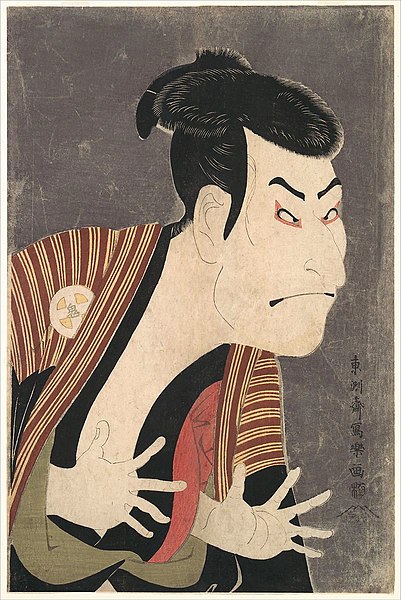Kyōganoko Musume Dōjōji (京鹿子娘道成寺), commonly called Musume Dōjōji, is a kabuki dance drama. It is the oldest surviving Noh-based Kabuki dance drama, which tells the story of a maiden who dances before a bell in the Dōjō-ji temple and then reveals herself to be a serpent-demon. The work is noted for its sequence of dances during which the performer dances for nearly an hour with nine changes of costume. It may be considered the most important piece in the kabuki dance repertoire, one that the onnagatas are required to learn to show their mastery of classic dances. It is classified as one of the hengemono that involve quick change of costumes and roles. Geisha and other dancers may also learn to perform parts of the dance as solo buyō dance pieces.
Depiction of a Kyō-ganoko Musume Dōjō-ji performance
The story of Musume Dojoji refers to a tale of a woman who transforms into a serpent-demon and destroys a temple bell
Nakamura Tomijūrō I performing one of the dances found in Musume Dojoji
Nakamura Utaemon VI in costume worn for Hanako's entrance in Musume Dōjōji, 1951
Kabuki is a classical form of Japanese theatre, mixing dramatic performance with traditional dance. Kabuki theatre is known for its heavily stylised performances, its glamorous, highly decorated costumes, and for the elaborate kumadori make-up worn by some of its performers.
The July 1858 production of Shibaraku at the Ichimura-za theater theatre in Edo. Triptych woodblock print by Utagawa Toyokuni III.
Onoe Kikugorō VI as Umeō-maru in Sugawara Denju Tenarai Kagami
The earliest portrait of Izumo no Okuni, the founder of kabuki (1600s)
Oniji Ōtani III (Nakazō Nakamura II) as Edobee in the May 1794 production of Koi Nyōbo Somewake Tazuna








